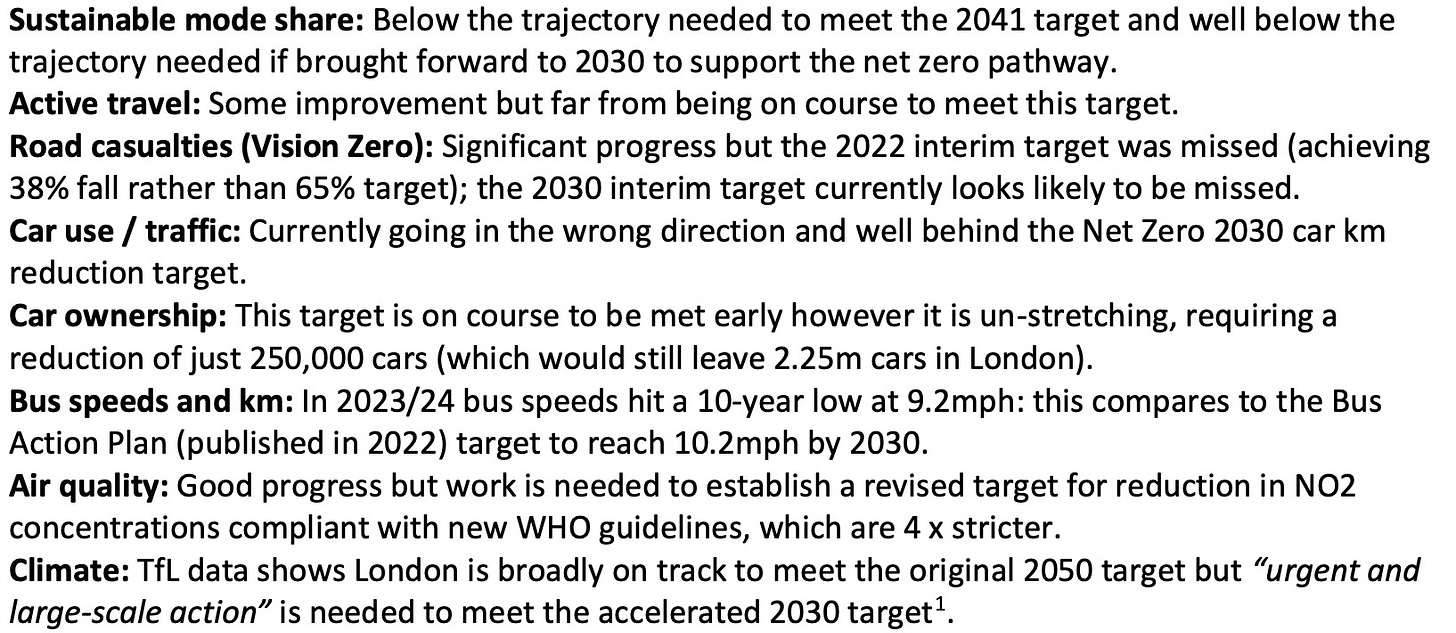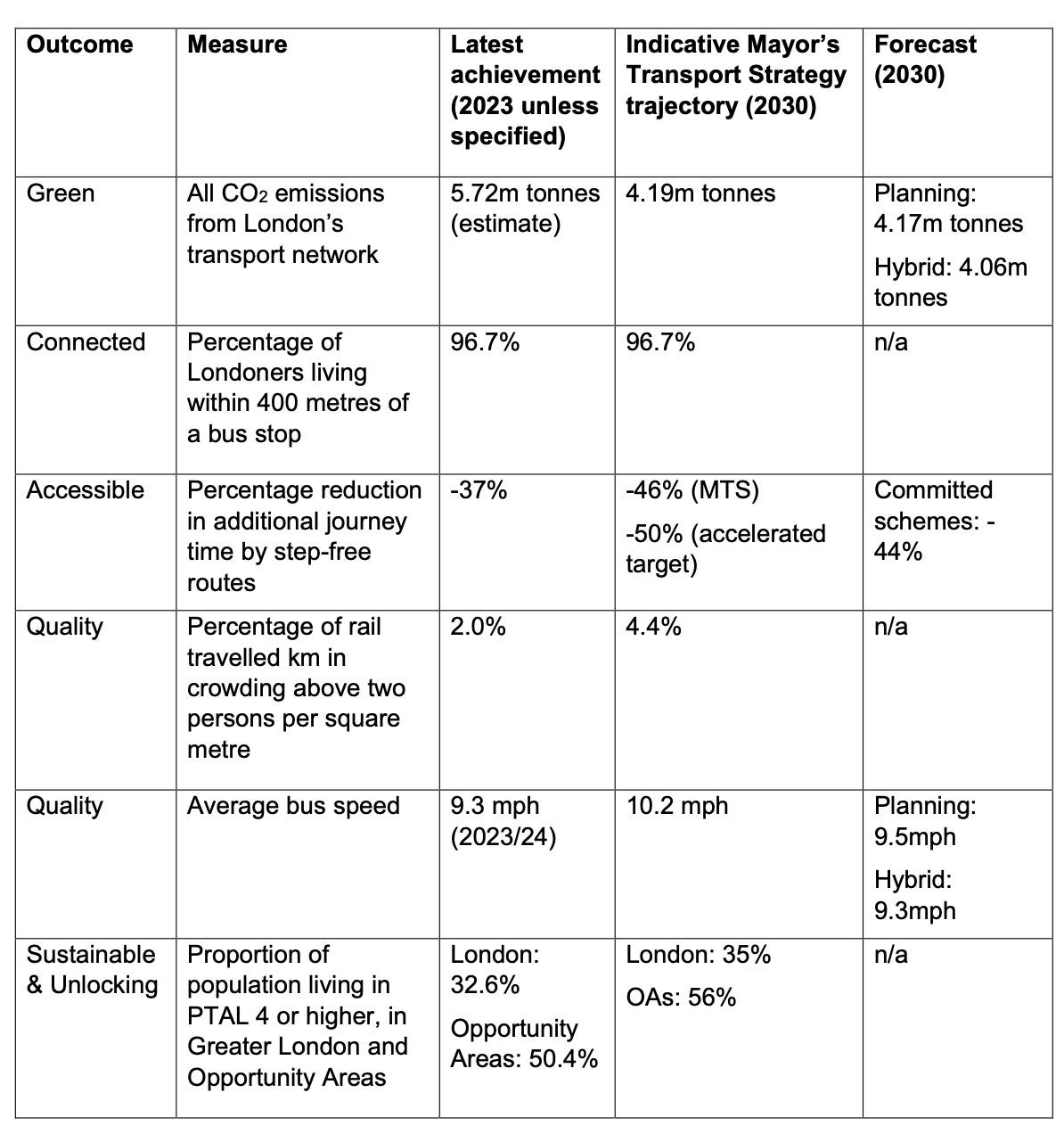Mayor’s Transport Strategy is shaping life in London — but not fast enough
Healthy Streets Scorecard are not impressed - story 53
When London Mayor Sir Sadiq Khan unveiled his ambitious Transport Strategy in 2018, the city was promised a bold reimagining of its streets: greener, safer, and less congested. Seven years on, the vision is taking shape — but the pace of progress remains far too slow.
The Mayor’s Transport Strategy (MTS), last updated in 2022, serves as a cornerstone for urban policy in London, influencing key decisions from traffic patterns to infrastructure investments. Its stated goals for 2041 are sweeping:
London’s streets will be healthy and more Londoners will travel actively
London’s streets will be safe and secure
London’s streets will be used more efficiently and have less traffic on them
London’s streets will be clean and green
The public transport network will meet the needs of a growing London
Public transport will be safe, affordable and accessible to all
Journeys by public transport will be pleasant, fast and reliable
Active, efficient and sustainable travel will be the best option in new homes and job developments
Transport investment will unlock the delivery of new homes and jobs
This list explains why transport is so important to Londoners and the role of the Mayor. With the future of Hammersmith Bridge still undecided it is particularly important to Barnes and Mortlake, the focus for this blog.
Progress after first six years
Mayor Khan’s administration publishes annual progress reports by Transport for London (TfL), the most recent of which was released in July 2024. The 121-page document is rich in data, detailing the performance of numerous programs across the city. The report’s conclusion says,
we have seen progress compared to last year on many of the outcomes, including mode share and safety; and notably strong progress on air quality since 2016.
But a coalition of transport and environmental advocacy groups take a dimmer view. Action Vision Zero, Clean Cities Campaign, CPRE London, Future Transport London, London Cycling Campaign, London Living Streets, Possible, Sustrans and Wheels for Wellbeing released their own review of the MTS in July 2024, warning that, under current conditions
.. a lack of progress means most targets won’t be met on the current trajectory
The headline chart on the first of an eight page report is telling:
The authors make three other significiant points.
They took into consideration
.. the Mayor’s preferred pathway to net zero by 2030, which requires TfL to bring forward MTS outcomes by 10 years.
They noted a ‘lack of progress by the boroughs’, saying there was
.. little or no progress from most boroughs on delivering the supporting infrastructure
Finally they point out
.. urgent and bold action is required now, focussed on traffic reduction and better use of road space.
Evidence, they say, shows de-prioritising space/capacity works. Traffic evaporation is the pleasing pair induced demand. I’ll return to that topic in a moment.
The 2020s: decisive decade ahead
TfL acknowledges the scale of the challenge. A strategic gap between current progress and long-term goals is clearly outlined in its own data. The 2024 Annual Report makes this sobering assessment:
Significant progress will be required this decade to remain on the trajectory towards the 2041 aims.
The numbers on these charts by TfL make clear the challenge.
TfL decided to focus on three key areas in the immediate future:
Improving bus journey times
More progress on safety
Continuing investment
While these may seem modest compared to the broader MTS goals, officials argue they are critical levers:
These areas are important as slower bus journey times mean fewer people travelling by bus, which may lead to more people travelling by car thus increasing traffic. In turn this slows buses further as well as increasing emissions and road danger. Slower buses also mean less revenue to reinvest in the network and more vehicles needed to maintain schedules which is resource that could otherwise have been used to enhance our services elsewhere
What does this mean for Hammersmith Bridge?
The debate over Hammersmith Bridge encapsulates the stakes of the Mayor’s vision. Reopening the historic structure to private vehicles could counteract gains made in reducing traffic and emissions.
In the context of the MTS, such a move would be tantamount to constructing a major new road — a step backwards in the fight against climate change and urban congestion.
If London is serious about reaching its 2041 targets — and possibly net zero by 2030 — policymakers must double down on strategies that discourage car use and promote public transport. That includes choosing options for infrastructure like Hammersmith Bridge that continue to cause difficulties in the short term.




